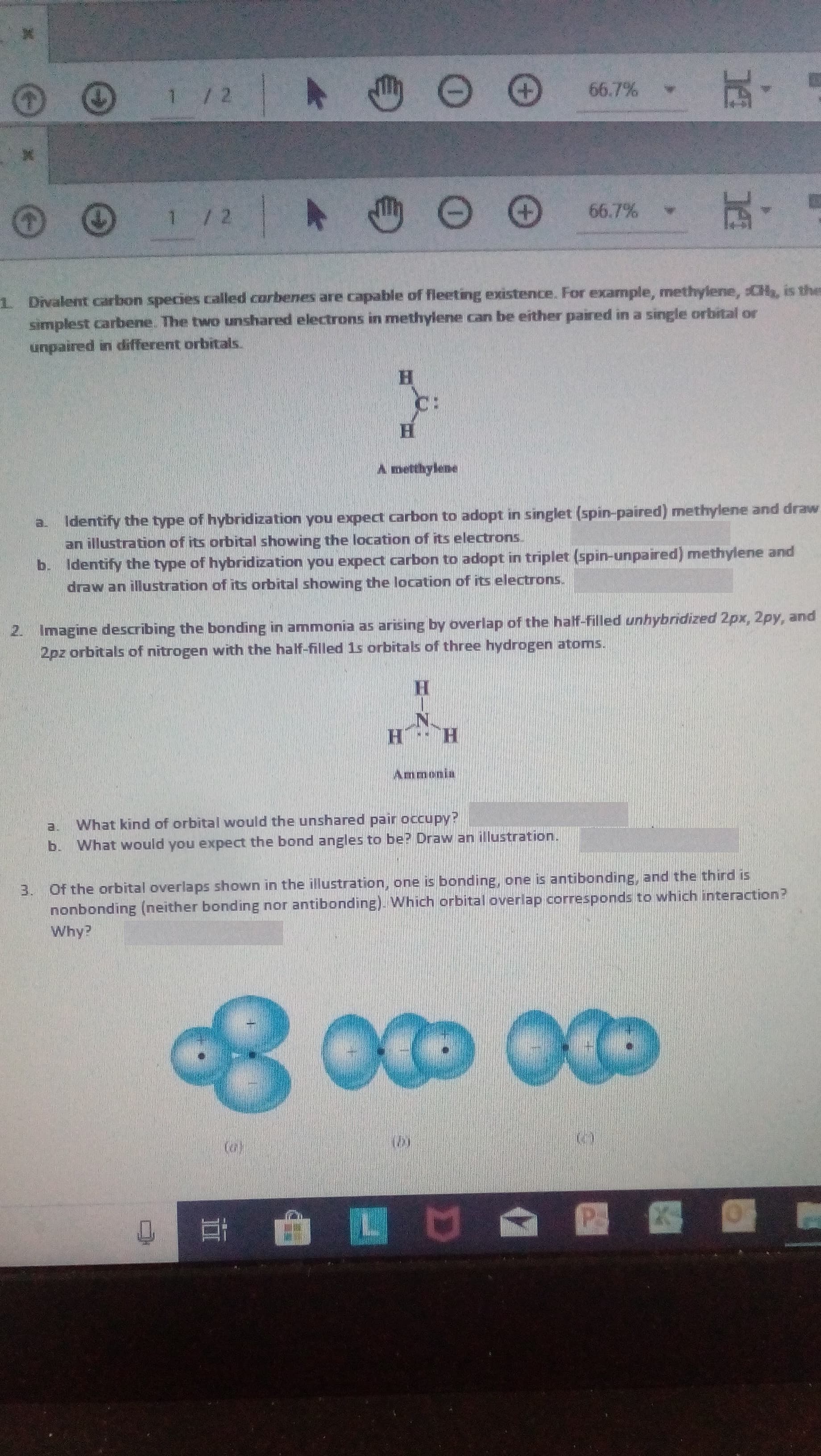1/2 66.7% 玩。 1/2 66.7% 1 Divalent carbon species called corbenes are capable of fleeting existence. For example, methylene, CH, is the simplest carbene. The two unshared electrons in methylene can be either paired in a single orbital or unpaired in different orbitals. C: A metthylene Identify the type of hybridization you expect carbon to adopt in singlet (spin-paired) methylene and draw an illustration of its orbital showing the location of its electrons. b. Identify the type of hybridization you expect carbon to adopt in triplet (spin-unpaired) methylene and draw an illustration of its orbital showing the location of its electrons. a. 2. Imagine describing the bonding in ammonia as arising by overlap of the half-filled unhybridized 2px, 2py, and 2pz orbitals of nitrogen with the half-filled 1s orbitals of three hydrogen atoms. H. H H Ammonia What kind of orbital would the unshared pair occupy? b. What would you expect the bond angles to be? Draw an illustration. 3. Of the orbital overlaps shown in the illustration, one is bonding, one is antibonding, and the third is nonbonding (neither bonding nor antibonding). Which orbital overlap corresponds to which interaction? Why? L 業 II
1/2 66.7% 玩。 1/2 66.7% 1 Divalent carbon species called corbenes are capable of fleeting existence. For example, methylene, CH, is the simplest carbene. The two unshared electrons in methylene can be either paired in a single orbital or unpaired in different orbitals. C: A metthylene Identify the type of hybridization you expect carbon to adopt in singlet (spin-paired) methylene and draw an illustration of its orbital showing the location of its electrons. b. Identify the type of hybridization you expect carbon to adopt in triplet (spin-unpaired) methylene and draw an illustration of its orbital showing the location of its electrons. a. 2. Imagine describing the bonding in ammonia as arising by overlap of the half-filled unhybridized 2px, 2py, and 2pz orbitals of nitrogen with the half-filled 1s orbitals of three hydrogen atoms. H. H H Ammonia What kind of orbital would the unshared pair occupy? b. What would you expect the bond angles to be? Draw an illustration. 3. Of the orbital overlaps shown in the illustration, one is bonding, one is antibonding, and the third is nonbonding (neither bonding nor antibonding). Which orbital overlap corresponds to which interaction? Why? L 業 II
Chemistry
10th Edition
ISBN:9781305957404
Author:Steven S. Zumdahl, Susan A. Zumdahl, Donald J. DeCoste
Publisher:Steven S. Zumdahl, Susan A. Zumdahl, Donald J. DeCoste
Chapter9: Covalent Bonding: Orbitals
Section: Chapter Questions
Problem 44E: Minoxidil (C9H15N15O) is a compound produced by the Pharmacia Upjohn Company that has been approved...
Related questions
Question
Solve these question

Transcribed Image Text:1/2
66.7%
玩。
1/2
66.7%
1 Divalent carbon species called corbenes are capable of fleeting existence. For example, methylene, CH, is the
simplest carbene. The two unshared electrons in methylene can be either paired in a single orbital or
unpaired in different orbitals.
C:
A metthylene
Identify the type of hybridization you expect carbon to adopt in singlet (spin-paired) methylene and draw
an illustration of its orbital showing the location of its electrons.
b. Identify the type of hybridization you expect carbon to adopt in triplet (spin-unpaired) methylene and
draw an illustration of its orbital showing the location of its electrons.
a.
2. Imagine describing the bonding in ammonia as arising by overlap of the half-filled unhybridized 2px, 2py, and
2pz orbitals of nitrogen with the half-filled 1s orbitals of three hydrogen atoms.
H.
H H
Ammonia
What kind of orbital would the unshared pair occupy?
b. What would you expect the bond angles to be? Draw an illustration.
3. Of the orbital overlaps shown in the illustration, one is bonding, one is antibonding, and the third is
nonbonding (neither bonding nor antibonding). Which orbital overlap corresponds to which interaction?
Why?
L
業
II
Expert Solution
This question has been solved!
Explore an expertly crafted, step-by-step solution for a thorough understanding of key concepts.
Step by step
Solved in 2 steps with 1 images

Knowledge Booster
Learn more about
Need a deep-dive on the concept behind this application? Look no further. Learn more about this topic, chemistry and related others by exploring similar questions and additional content below.Recommended textbooks for you

Chemistry
Chemistry
ISBN:
9781305957404
Author:
Steven S. Zumdahl, Susan A. Zumdahl, Donald J. DeCoste
Publisher:
Cengage Learning

Chemistry: The Molecular Science
Chemistry
ISBN:
9781285199047
Author:
John W. Moore, Conrad L. Stanitski
Publisher:
Cengage Learning

Chemistry: An Atoms First Approach
Chemistry
ISBN:
9781305079243
Author:
Steven S. Zumdahl, Susan A. Zumdahl
Publisher:
Cengage Learning

Chemistry
Chemistry
ISBN:
9781305957404
Author:
Steven S. Zumdahl, Susan A. Zumdahl, Donald J. DeCoste
Publisher:
Cengage Learning

Chemistry: The Molecular Science
Chemistry
ISBN:
9781285199047
Author:
John W. Moore, Conrad L. Stanitski
Publisher:
Cengage Learning

Chemistry: An Atoms First Approach
Chemistry
ISBN:
9781305079243
Author:
Steven S. Zumdahl, Susan A. Zumdahl
Publisher:
Cengage Learning

Chemistry: Principles and Practice
Chemistry
ISBN:
9780534420123
Author:
Daniel L. Reger, Scott R. Goode, David W. Ball, Edward Mercer
Publisher:
Cengage Learning

General Chemistry - Standalone book (MindTap Cour…
Chemistry
ISBN:
9781305580343
Author:
Steven D. Gammon, Ebbing, Darrell Ebbing, Steven D., Darrell; Gammon, Darrell Ebbing; Steven D. Gammon, Darrell D.; Gammon, Ebbing; Steven D. Gammon; Darrell
Publisher:
Cengage Learning
